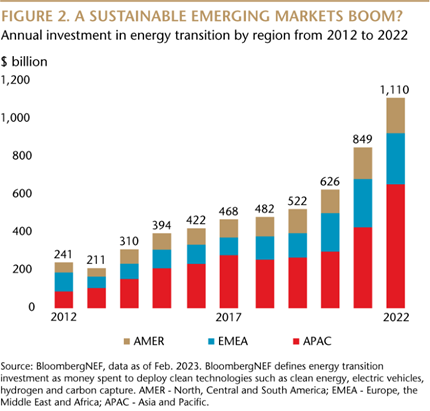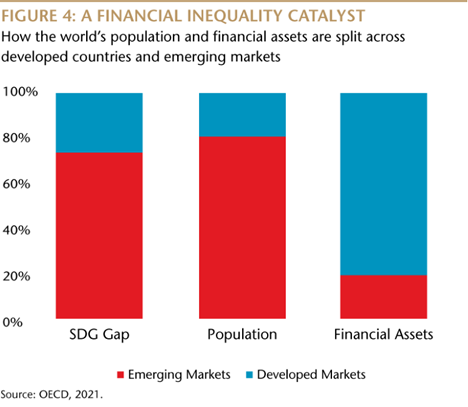Remember the commodities boom? It was the bull market of the early 2000s that was largely propelled by the emerging markets. It also helped those economies become a critical component of the balanced portfolios that we know today.
The boom showed the latent power and long-term potential of emerging markets and highlighted the value of the asset class for equity investors. One challenge to be mindful of, however, particularly when it comes to long-term secular opportunities, is that growth in emerging markets can be extreme and narrowly focused. And after the boom, the future expansion of some markets can seem ordained in a certain direction.
The market rally of the 2000s, for example, was essentially a commodities-led boom for emerging markets in Asia, Latin America and elsewhere, and closely tied to resources-intensive sectors, like energy and materials. More than 20 years later, many emerging economies either remain focused in commodities or their industries remain heavily dependent on fossil fuels.
Now, as the world tries to carve out a sustainable, low-carbon path, these old economy traits undoubtedly present a systemic challenge. As ESG considerations have become increasingly critical for investors and portfolio managers, many emerging markets, seen through a sustainable lens, have found themselves lagging the progress of much of the developed world. Investors, in turn, have found themselves unsure of how best to think about effective, sustainable emerging markets exposure in their portfolios.
While it is inarguable emerging markets have ample work to transition their economies onto a sustainable footing, this gap with the developed world introduces a tremendous investment opportunity. It raises the possibility that the next emerging markets-led bull market could be as powerful as the rally two decades ago though this time, powered by companies on the leading edge of crafting a global sustainable future.
Sustainable potential
These transition to low carbon will require economies to either change their entire energy mix by shifting from old industry to new secular industrial drivers, such as 5G, big data and electric vehicles, or increase the economic role of services industries, which tend to be less carbon-intensive. Pursuing either of these transitions, or a combination of both, introduces the possibility of an early 2000s-like intensive growth phase for some emerging markets in the future.
The scale of the sustainable transitions facing emerging markets is significant. For example, achieving the cumulative reduction in fossil fuel reliance which countries globally have committed to in multilateral climate-related pledges is heavily reliant on technologies not currently commercially available. These technologies will require innovative companies and massive capital investments in order to meet targets like those outlined in the UN Sustainable Development Goals (SDGs), which call for an estimated $5trn to $7trn annual investment.

China is the linchpin
China represents the linchpin for sustainable change in emerging markets. Its economy is heavily coal-fired and for decades it has led Asia to generate nearly 90% of global carbon emissions growth. For China to decarbonise its economy it will need to become less reliant on industry and for industry to become less reliant on coal.
See also: – China accelerates coal plant construction
As things currently stand, cement, steel, infrastructure and overall industrial output are China’s main economic drivers and power generation and industrial activity account for some 75% of China’s emissions. While there has been a recent, modest shift away from old industry and toward new enterprise, the impact on China’s emissions is a long way from being noticeable or noteworthy.
And regardless of whether China hastens to newer, less energy-intensive industry or attempts to shift to a more services-oriented economy, it will first have to increase its supply of clean power as its power grid currently doesn’t accommodate enough renewables to meet its energy demand.
Financial inclusion gap
The transition is also about addressing socioeconomic issues such as inequality, which was intensified by the Covid-19 pandemic. Inequality is acutely felt in emerging countries as they tend to have large informal economic sectors, greater regional differences in wealth levels, wider educational access gaps and higher barriers to employment for women.
This inequality is exacerbated by a financial inclusion gap between the developed and emerging worlds. The reality is most of the globe’s financial assets are in developed countries while the majority of world’s population and most of the UN’s SDG funding gap is in emerging markets.
Large sections of the populations in many emerging markets across Asia, Africa and Latin America still lack access to basic banking services, hampering their economic development, wealth generation, and progress toward developing industries and services for a sustainable future.

Investing in EMs
To get an enduring and balanced exposure to these potentially gigantic trends investors should take an informed approach using a diversified, well-researched strategy that views emerging markets in Asia and throughout the world with a long-term sustainable lens—rather than targeting exposures to specific sectors and markets.
Successfully investing in emerging markets involves not just choosing quality companies within growing markets and industries, but also attempting to avoid risks associated with unanticipated government policies, regulatory oversight and geopolitical considerations. Sustainable strategies can help mitigate these risks through thoughtful stock selection and an approach that can align with government policies.
For investors with existing emerging markets exposure, sustainable emerging markets investments can act as a complement. The key to ensuring sufficient diversification is evaluating existing holdings in terms of exposure to market caps, sectors, countries, and growth versus value, and then selecting a sustainable emerging markets strategy that offers alternative exposures. For example, an investor with a passive emerging markets exchange traded fund or a more value, cyclically-oriented emerging markets fund could benefit from a small- or mid-cap, growth-oriented sustainable strategy.
